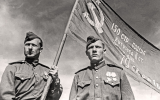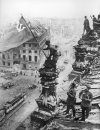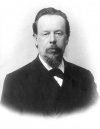Loxuru
Graf von Kreuzigung
Only one day after he got married! It must have been a real turnoff for the poor guy!On April 30, Red Army soldiers drove an Austrian artist to suicide.View attachment 1466617View attachment 1466618View attachment 1466623


Only one day after he got married! It must have been a real turnoff for the poor guy!On April 30, Red Army soldiers drove an Austrian artist to suicide.View attachment 1466617View attachment 1466618View attachment 1466623

Yeah, a world class case of cold feet at the alter.Only one day after he got married! It must have been a real turnoff for the poor guy!


A very sad day for F1 fans, and a great loss to the racing world.30 years ago, on May 1, 1994, the legendary Ayrton Senna, three-time world champion in the Formula 1 class, crashed at the Imola circuit. View attachment 1467194
For me, the greatest (in spite of Alain Prost, Michael Schumacher, Lewis Hamilton...)... and also the craziest!30 years ago, on May 1, 1994, the legendary Ayrton Senna, three-time world champion in the Formula 1 class, crashed at the Imola circuit. View attachment 1467194
I recently watched a documentary about him, and learned that a rules change in F1 may have played into his fatal crash. The cars his team were driving had some form of new technology that assisted in traction control and stability (if I recall correctly), and the cars were basically designed around that. The F1 governing body decided they had an unfair advantage and banned use of that technology. Senna and his team mates had drive the cars with that tech disabled, which made them unstable, and there was no way to modify the cars to go without it.For me, the greatest (in spite of Alain Prost, Michael Schumacher, Lewis Hamilton...)... and also the craziest!


Congratulations on your summary of a piece of French History!A little bit of history to entertain your day : on May 20th 1824, two hundred years ago, Charles X was crowned as King of France. He would be the last ruling absolutist monarch in France, and the last to get a coronation in the Reims Cathedral. Charles X was the last surviving brother of Louis XVI, who lost his head on the guillotine, 31 years earlier. The latter’s only son, Louis VII, had died ten years old in captivity, also during the revolution. After the fall of Napoleon in 1815, France had restored the absolutist monarchy from before the revolution, as if nothing had happened. With no more male issue from Louis XVI alive, the throne went to the latter’s oldest living brother, Louis XVIII, who died in 1824. Since he had neither male issue, the throne went to the next younger brother, Charles X.
However, the revolutionary spirit was not dead in France. In July 1830, an uprise forced Charles X to abdicate. In an attempt to rescue the monarchy, he passed the throne to his son, Louis XIX, but whose reign only lasted…twenty minutes, before he abdicated in turn, in favour of his 4 years old nephew, Henry V. The latter’s formal ‘reign’ would last only seven days. Ultimately, it was a distant family member of the Bourbons, Louis-Philippe, who became king, but who was forced to accept a constitutional reign, instead of ruling as an absolutist monarch.
The next decades, “Henry V” would maintain his claims on the throne, throughout the July-monarchy (1830-1848), the Second Republic (1848-1852), and the Second Empire (1852-1870). In 1873, in the chaos following the defeat in the French-Prussian War, the fall of the empire, and the Paris Commune, he saw his chance to seize power. From the Chambord Castle he prepared his March on Paris. But even before he started, he was already confronted with so many conditions and restrictions of power he should have to accept, preventing him to become an absolutist monarch, that he gave up his plan. In the Chambord Castle, the carriages in which he wanted to drive to Paris, are still exposed today.
True! Originally, the title was 'King of the Franks'. Around 1300, Philippe IV changed that into 'King of France', thereby more or less legitimating the status of dynastic succession that had been informally established since a few centuries. Officially, the kings in France (as elsewhere in Europe) were to be elected among and by nobles, as a sort of president for life. Louis-Philippe was however a constitutional monarch, and this status was reflected in the new title 'King of the French'.A little addition: Charles X was the last "Roi de France" (King of France), as his successor Louis-Philippe called himself "Roi des Français" (King of the French).
True! Originally, the title was 'King of the Franks'. Around 1300, Philippe IV changed that into 'King of France', thereby more or less legitimating the status of dynastic succession that had been informally established since a few centuries. Officially, the kings in France (as elsewhere in Europe) were to be elected among and by nobles, as a sort of president for life. Louis-Philippe was however a constitutional monarch, and this status was reflected in the new title 'King of the French'.
A similar title was given in 1830 to the constitutional monarchs of Belgium (King of the Belgians), while in the other European monarchies, (UK, Norway, Sweden, Denmark, Spain, The Netherlands), the pre-constitutional titles (King/Queen of Spain, Denmark,...) are still maintained.
Our sovereigns, when we had them, were Kings of Scots, or in the case of Mary, Queen of Scots. In earlier medieval times, rulers were more generally of people rather than of lands - rex Anglorum etc. As your example of France shows, the association with territory came with feudal lordship, the revival of headship of a people with Romantic nationalism (King of the Hellenes being another example)True! Originally, the title was 'King of the Franks'. Around 1300, Philippe IV changed that into 'King of France', thereby more or less legitimating the status of dynastic succession that had been informally established since a few centuries. Officially, the kings in France (as elsewhere in Europe) were to be elected among and by nobles, as a sort of president for life. Louis-Philippe was however a constitutional monarch, and this status was reflected in the new title 'King of the French'.
A similar title was given in 1830 to the constitutional monarchs of Belgium (King of the Belgians), while in the other European monarchies, (UK, Norway, Sweden, Denmark, Spain, The Netherlands), the pre-constitutional titles (King/Queen of Spain, Denmark,...) are still maintained.

